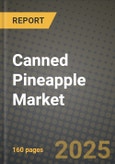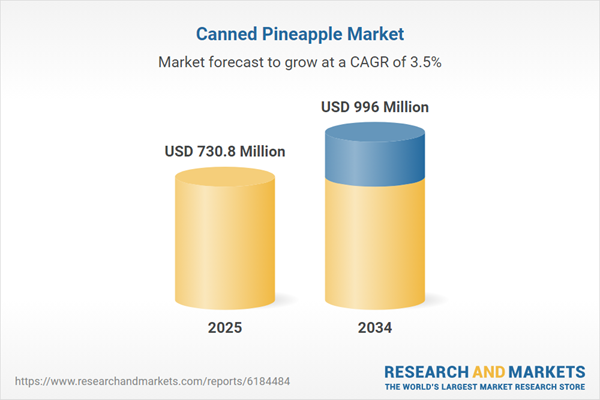Canned Pineapple Market
The canned pineapple market sits at the intersection of affordable indulgence, pantry-stable convenience, and year-round availability, serving both retail and professional kitchens worldwide. Demand spans classic household uses (desserts, baking, smoothies, salads) and foodservice staples (pizza toppings, buffet service, cocktails, ready meals), with industrial users incorporating crushed and tidbits into yogurts, bakery fillings, sauces, and fruit preparations. The product mix is anchored by slices and chunks, with tidbits and crushed variants expanding in industrial and bakery channels; pack media are diversifying from heavy syrup to juice-packed and water-packed alternatives aligned to sugar-reduction goals. Brands and private labels compete on provenance, consistency, and price, while vertically integrated growers in Southeast Asia and Latin America emphasize secure supply and traceability. Packaging innovation centers on BPA-NI linings, easy-open ends, and portionable formats to reduce waste for HoReCa and small households. E-commerce and club formats are expanding multi-packs and family sizes, while convenience retail favors single-serve and petite cans. Seasonal climate variability and agronomic cycles influence fruit solids and brix, requiring tight procurement planning and flexible specifications for industrial buyers. Tinplate cost swings, freight volatility, and currency movements remain key cost drivers, prompting more hedging and multi-origin sourcing strategies. Sustainability messaging - responsible agriculture, water stewardship, and ethical labor practices - supports premium positioning in developed markets, while price remains decisive in value-conscious regions. Overall, the category continues to benefit from recipe versatility, globalized cuisines, and a resilient shelf-stable value proposition that complements fresh and frozen formats rather than competing head-to-head.Canned Pineapple Market Key Insights
- Product format dynamics. Slices and standard chunks anchor retail, while tidbits and crushed gain share in bakery, dairy, and sauce applications. Industrial buyers prioritize uniform dice, drain weight consistency, and brix targets to stabilize recipes. Easy-open ends and BPA-NI linings are table stakes in developed markets. Portionable, multi-serve, and small-format cans address waste and single-household needs.
- Shift in packing media. Juice-packed and water-packed variants are expanding as retailers cut added sugars across center-store categories. Foodservice still values syrup for texture and flavor carry-through in heat-processed dishes. Manufacturers balance sweetness, mouthfeel, and yield to meet reformulation targets. Clear front-of-pack claims support shopper trade-up.
- Supply security and multi-origin sourcing. Leading processors diversify plantations and contract farming across Southeast Asia and Latin America to mitigate climate and phytosanitary risks. Multi-origin blending helps maintain cut integrity and flavor. Buyers increasingly require dual-plant qualifications and rolling quality audits. Forward contracts smooth spot market shocks.
- Private label versus brands. Private labels leverage scale, standardized specs, and promotional cycles to win value-oriented baskets. Brands differentiate with provenance stories, sustainability programs, and culinary inspiration. Co-packing partnerships allow rapid line extensions. Assortment rationalization in large retailers heightens execution discipline.
- Foodservice resilience. Pizzerias, QSRs, and buffet chains favor #10 cans and pouch formats for speed and yield. Consistent cut size drives throughput and topping coverage. Re-closures and portion control reduce waste in variable-traffic outlets. Distributor programs emphasize slotting reliability and rebate structures.
- Packaging and compliance. BPA-NI linings, migration compliance, and can integrity (double seam) are non-negotiable for major retailers. Traceable lots and supplier scorecards standardize audits across geographies. Secondary packaging optimization targets logistics efficiency. Recyclability messaging supports ESG scorecards.
- Cost and margin management. Tinplate, energy, labor, and container rates shape delivered cost. Manufacturers employ hedging, lightweighting, and line efficiency gains to protect margins. Mix management (premium juice-packed, provenance SKUs) offsets promotional pressure. Yield improvement from varietal selection supports cost predictability.
- Route-to-market evolution. Club and e-commerce expand multi-packs and pantry-stocking missions, while convenience formats push small cans. Digital shelves reward rich content (drain weight clarity, usage ideas, nutrition cues). In emerging markets, traditional trade remains critical; case sizes and credit terms are localized.
- Sustainability and certification. Responsible agriculture, biodiversity buffers, water use metrics, and ethical labor codes are increasingly embedded in supplier selection. Carbon-smart logistics and renewable energy at plants support retail ESG goals. Transparent reporting and third-party validations underpin premium positioning.
- Culinary and cultural adoption. Global cuisine cross-pollination sustains demand beyond desserts - savoury rice dishes, sweet-sour proteins, and fusion pizzas normalize pineapple as a versatile ingredient. Content marketing and chef partnerships stimulate at-home experimentation. Industrial R&D incorporates pineapple into better-for-you snacks and dairy.
Canned Pineapple Market Reginal Analysis
North America
Demand is anchored by mainstream retail and robust foodservice consumption, especially pizza, Tex-Mex, and buffet formats. Retailers emphasize clean labels, juice-packed variants, and BPA-NI packaging, with private labels strongly represented. Club channels drive multi-pack velocities, while e-commerce penetration supports pantry-loading. Buyers expect dual-origin coverage to manage weather and freight volatility. Sustainability scorecards and supplier OTIF performance heavily influence category reviews.Europe
Sugar-reduction policies and label scrutiny accelerate juice- and water-packed growth, with stringent packaging and migration standards. Northern and Western Europe prioritize provenance stories, ethical sourcing, and recyclability; Southern Europe sustains hospitality-led demand. Discounters and private label dominate volume, pressing manufacturers for cost transparency and steady service levels. Port disruptions and logistics lead times shape seasonal procurement calendars. Recipe inspiration around bakery and yogurt inclusions supports premium rotations.Asia-Pacific
As a core producing region, APAC combines export-oriented processors with rising intra-regional consumption. Domestic markets in Southeast Asia favor value formats and syrup-packed profiles, while developed APAC (Japan, Australia, Korea) leans towards clean-label and portion-controlled cans. Processors invest in agronomy, varietal selection, and line automation to stabilize quality and yields. Regional trade agreements and flexible container routing help mitigate shipping volatility.Middle East & Africa
Stable shelf-life and ambient distribution suit hot climates and extended supply chains. Imports from Asia dominate, with price sensitivity driving private label and value brands. Modern trade expansion improves assortment, while traditional trade depends on resilient secondary packaging. Hospitality hubs demand foodservice sizes for mixed rice dishes, grills, and buffet service. Customs standards and halal compliance shape labeling and supplier qualification. Currency and freight swings influence promotional cadence.South & Central America
Local fruit production coexists with imports to balance seasonality and specifications. Retailers blend private label with established brands, and price points remain decisive for volume movement. Foodservice channels - especially pizza and casual dining - sustain steady demand for large-format packs. Processors emphasize agronomic improvements, water management, and energy efficiency to strengthen cost positions. Cross-border logistics and port capacity planning affect lead times and safety stock strategies across the region.Canned Pineapple Market Segmentation
By Type
- Pineapple Slices
- Pineapple Chunks
By Application
- Beverages & Drinks
- Bakery & Snacks
- Others
By Distribution Channel
- Supermarkets/Hypermarkets
- Convenience Stores
- Online Retail
- Others
Key Market players
Dole Packaged Foods, Del Monte Philippines (DMPI), Del Monte Foods (US), Fresh Del Monte Produce, Hosen Group, Princes Group, Ayam Brand, Malee Group PCL, Tipco Foods PCL, Thai Pineapple Canning Industry (TPC) PCL, Siam Food Products PCL, Great Giant Pineapple (PT GGP), Natural Fruit Co. Ltd., Hotei Foods Corporation, Pacific Coast ProducersCanned Pineapple Market Analytics
The report employs rigorous tools, including Porter’s Five Forces, value chain mapping, and scenario-based modelling, to assess supply-demand dynamics. Cross-sector influences from parent, derived, and substitute markets are evaluated to identify risks and opportunities. Trade and pricing analytics provide an up-to-date view of international flows, including leading exporters, importers, and regional price trends.Macroeconomic indicators, policy frameworks such as carbon pricing and energy security strategies, and evolving consumer behaviour are considered in forecasting scenarios. Recent deal flows, partnerships, and technology innovations are incorporated to assess their impact on future market performance.
Canned Pineapple Market Competitive Intelligence
The competitive landscape is mapped through proprietary frameworks, profiling leading companies with details on business models, product portfolios, financial performance, and strategic initiatives. Key developments such as mergers & acquisitions, technology collaborations, investment inflows, and regional expansions are analyzed for their competitive impact. The report also identifies emerging players and innovative startups contributing to market disruption.Regional insights highlight the most promising investment destinations, regulatory landscapes, and evolving partnerships across energy and industrial corridors.
Countries Covered
- North America - Canned Pineapple market data and outlook to 2034
- United States
- Canada
- Mexico
- Europe - Canned Pineapple market data and outlook to 2034
- Germany
- United Kingdom
- France
- Italy
- Spain
- BeNeLux
- Russia
- Sweden
- Asia-Pacific - Canned Pineapple market data and outlook to 2034
- China
- Japan
- India
- South Korea
- Australia
- Indonesia
- Malaysia
- Vietnam
- Middle East and Africa - Canned Pineapple market data and outlook to 2034
- Saudi Arabia
- South Africa
- Iran
- UAE
- Egypt
- South and Central America - Canned Pineapple market data and outlook to 2034
- Brazil
- Argentina
- Chile
- Peru
Research Methodology
This study combines primary inputs from industry experts across the Canned Pineapple value chain with secondary data from associations, government publications, trade databases, and company disclosures. Proprietary modeling techniques, including data triangulation, statistical correlation, and scenario planning, are applied to deliver reliable market sizing and forecasting.Key Questions Addressed
- What is the current and forecast market size of the Canned Pineapple industry at global, regional, and country levels?
- Which types, applications, and technologies present the highest growth potential?
- How are supply chains adapting to geopolitical and economic shocks?
- What role do policy frameworks, trade flows, and sustainability targets play in shaping demand?
- Who are the leading players, and how are their strategies evolving in the face of global uncertainty?
- Which regional “hotspots” and customer segments will outpace the market, and what go-to-market and partnership models best support entry and expansion?
- Where are the most investable opportunities - across technology roadmaps, sustainability-linked innovation, and M&A - and what is the best segment to invest over the next 3-5 years?
Your Key Takeaways from the Canned Pineapple Market Report
- Global Canned Pineapple market size and growth projections (CAGR), 2024-2034
- Impact of Russia-Ukraine, Israel-Palestine, and Hamas conflicts on Canned Pineapple trade, costs, and supply chains
- Canned Pineapple market size, share, and outlook across 5 regions and 27 countries, 2023-2034
- Canned Pineapple market size, CAGR, and market share of key products, applications, and end-user verticals, 2023-2034
- Short- and long-term Canned Pineapple market trends, drivers, restraints, and opportunities
- Porter’s Five Forces analysis, technological developments, and Canned Pineapple supply chain analysis
- Canned Pineapple trade analysis, Canned Pineapple market price analysis, and Canned Pineapple supply/demand dynamics
- Profiles of 5 leading companies - overview, key strategies, financials, and products
- Latest Canned Pineapple market news and developments
Additional Support
With the purchase of this report, you will receive:- An updated PDF report and an MS Excel data workbook containing all market tables and figures for easy analysis.
- 7-day post-sale analyst support for clarifications and in-scope supplementary data, ensuring the deliverable aligns precisely with your requirements.
- Complimentary report update to incorporate the latest available data and the impact of recent market developments.
This product will be delivered within 1-3 business days.
Table of Contents
Companies Mentioned
- Dole Packaged Foods
- Del Monte Philippines (DMPI)
- Del Monte Foods (US)
- Fresh Del Monte Produce
- Hosen Group
- Princes Group
- Ayam Brand
- Malee Group PCL
- Tipco Foods PCL
- Thai Pineapple Canning Industry (TPC) PCL
- Siam Food Products PCL
- Great Giant Pineapple (PT GGP)
- Natural Fruit Co. Ltd.
- Hotei Foods Corporation
- Pacific Coast Producers
Table Information
| Report Attribute | Details |
|---|---|
| No. of Pages | 160 |
| Published | November 2025 |
| Forecast Period | 2025 - 2034 |
| Estimated Market Value ( USD | $ 730.8 Million |
| Forecasted Market Value ( USD | $ 996 Million |
| Compound Annual Growth Rate | 3.5% |
| Regions Covered | Global |
| No. of Companies Mentioned | 15 |









